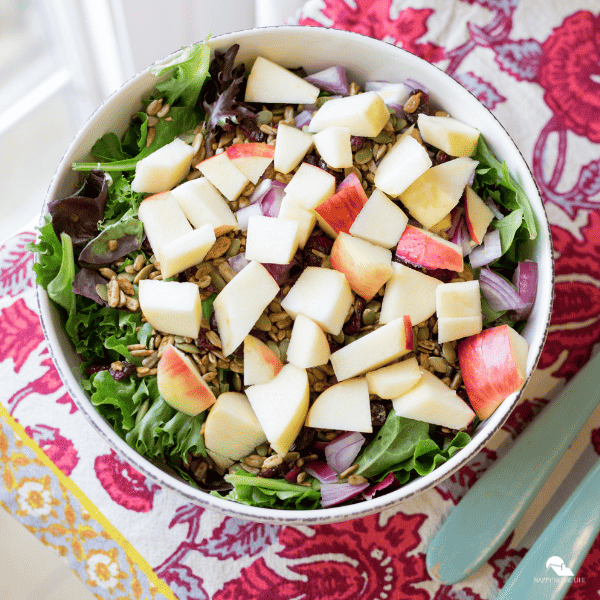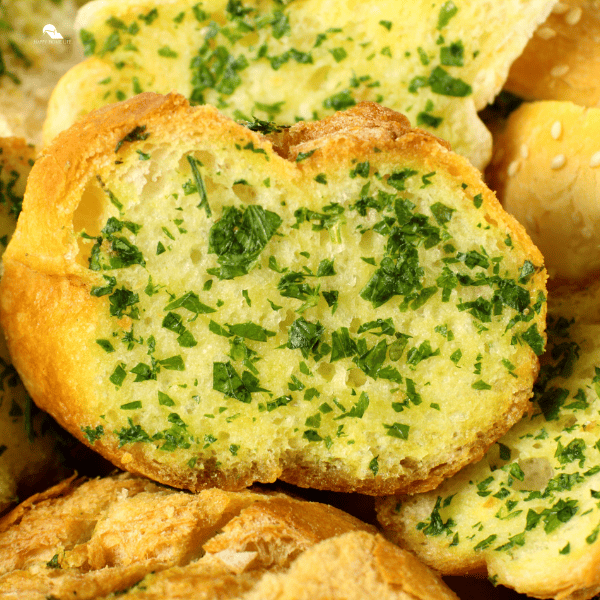Have you asked yourself what a Mediterranean salad contains? This question also unravels a culinary tapestry that reflects the rich heritage and flavors of the Mediterranean region.
Renowned for its emphasis on fresh, wholesome ingredients, a Mediterranean salad is a gastronomic journey through the sun-kissed landscapes that border the Mediterranean Sea. This vibrant dish encapsulates a harmonious blend of textures, colors, and tastes, offering a delectable glimpse into the diverse and healthful aspects of Mediterranean cuisine.

A classic Mediterranean salad is a delightful fusion of fresh vegetables such as tomatoes, cucumbers, bell peppers, and red onions, each contributing its unique crunch and vibrant hue.
Complementing these vegetables are the signature elements of Mediterranean cuisine, including olives for a briny kick, crumbled feta cheese for creaminess, and a drizzle of extra virgin olive oil that ties the ingredients together.
Further elevating the salad’s profile are the aromatic notes of herbs like basil, oregano, and parsley, while a light dressing made with lemon juice or balsamic vinegar imparts a refreshing acidity.
This culinary masterpiece is completed with a hint of garlic and the addition of capers, creating a symphony of flavors that captures the essence of the Mediterranean’s culinary artistry.
What is Mediterranean salad made of?

A Mediterranean salad typically includes a variety of fresh and flavorful ingredients commonly found in the Mediterranean region. While there can be variations, a basic Mediterranean salad may include the following components:
- Greens: Typically, a mix of fresh leafy greens such as romaine lettuce, arugula, or spinach.
- Vegetables: Chopped tomatoes, cucumbers, red onions, and bell peppers are common choices.
- Olives: Kalamata olives or other varieties add a briny and salty flavor.
- Cheese: Feta cheese is a classic choice, crumbled over the salad for a creamy and tangy element.
- Herbs: Fresh herbs like oregano, basil, or parsley are often used to enhance the flavor.
- Dressing: A simple dressing made with olive oil, lemon juice, garlic, and herbs is common. Balsamic vinegar or red wine vinegar may also be used.
- Extras: Some variations may include ingredients like capers, artichoke hearts, or roasted red peppers for additional flavor and texture.
What is the difference between a Greek salad and a Mediterranean salad?
A Greek salad and a Mediterranean salad are similar in many ways, as they both draw inspiration from the Mediterranean region. However, there are a few key differences between the two:
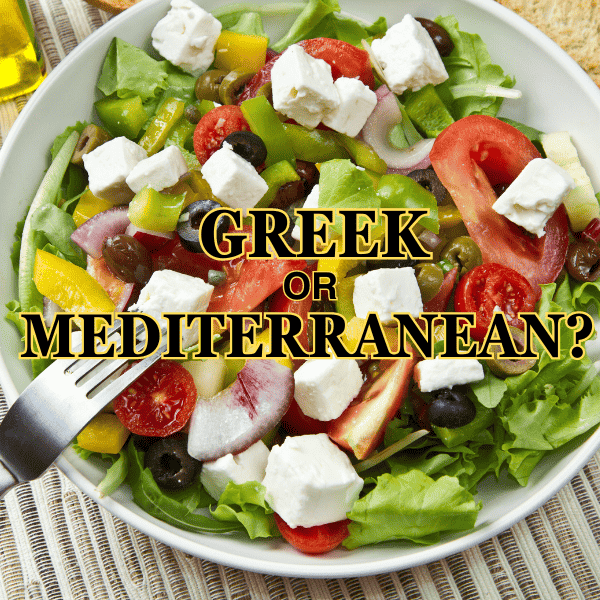
Ingredients
The main ingredients in a Greek salad are tomatoes, cucumbers, red onions, Kalamata olives, and feta cheese. It is often seasoned with oregano and dressed with olive oil and lemon juice.
On the other hand, a Mediterranean salad may have a wider variety of ingredients, including additional vegetables like bell peppers, artichoke hearts, and roasted red peppers. It may also include other cheeses like mozzarella or goat cheese.
Dressing
While a Greek salad is traditionally dressed with olive oil and lemon juice, a Mediterranean salad can be dressed with a variety of dressings such as balsamic vinaigrette, red wine vinegar, or even yogurt-based dressings.
Herbs and spices
Greek salads typically feature the herb oregano as the predominant seasoning. In contrast, Mediterranean salads might incorporate a wider range of herbs and spices, such as basil, parsley, cilantro, or mint.
Culinary traditions
Greek salad is a classic dish from Greek cuisine, while the term “Mediterranean salad” is more of a broad description encompassing various salads inspired by the Mediterranean region, which includes countries like Italy, France, Spain, and Morocco.
Why is Mediterranean salad healthy?

Mediterranean salad is considered healthy due to its abundant use of fresh, nutrient-rich ingredients that are characteristic of the Mediterranean diet. The Mediterranean diet has been widely recognized as one of the healthiest diets in the world, with numerous studies linking it to various health benefits.
Firstly, Mediterranean salads are typically loaded with vegetables and leafy greens such as tomatoes, cucumbers, bell peppers, and lettuce. These vegetables are rich in fiber, antioxidants, vitamins, and minerals, contributing to overall good health.
Fiber promotes digestive health, helps maintain a healthy weight, and reduces the risk of chronic diseases like heart disease and type 2 diabetes. Antioxidants found in vegetables help protect the body from damage caused by harmful free radicals.
Secondly, Mediterranean salads often contain extra-virgin olive oil as a dressing. Olive oil is a key Mediterranean diet component and a healthier alternative to other oils or creamy dressings.
It is packed with monounsaturated fatty acids, which have been shown to improve heart health by reducing bad cholesterol levels. Olive oil also contains polyphenols, which have anti-inflammatory properties and may help reduce the risk of chronic diseases like cancer and Alzheimer’s disease.
Are Mediterranean salads good for you?
Mediterranean salads are indeed good for you. Packed with a variety of fresh vegetables like tomatoes, cucumbers, and bell peppers, these salads provide essential vitamins, minerals, and fiber that promote overall health. The use of olive oil as a dressing adds monounsaturated fats, which can improve heart health.
Additionally, Mediterranean salads often incorporate ingredients like low-fat feta cheese, beans, and dark leafy greens, which further enhance the nutritional value. Studies suggest that following a Mediterranean diet, which includes Mediterranean salads, may help prevent heart disease, stroke, and other chronic illnesses.
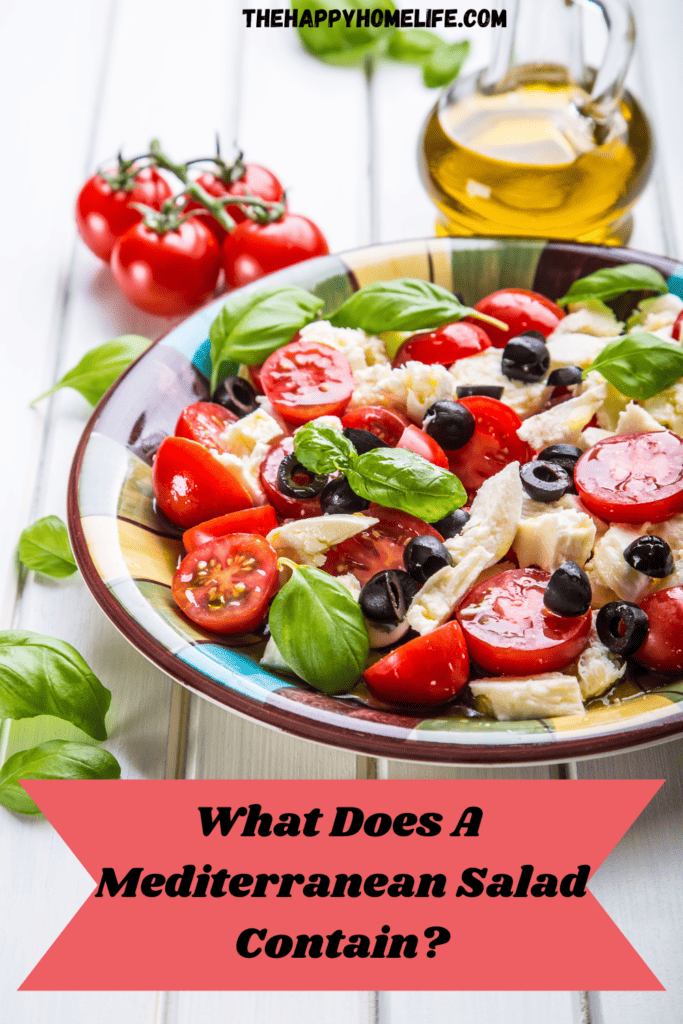
Mediterranean Pasta Salad with Lemon Vinaigrette
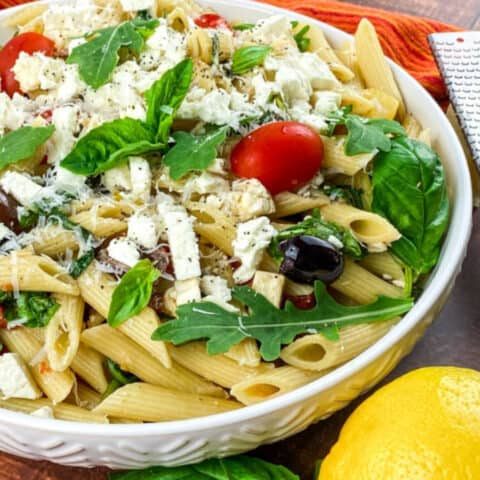
This salad offers a variety of flavors in every mouthful, from the peppery bite of arugula to the saltiness of Kalamata olives and Feta cheese. The robust taste is complemented by penne pasta and made more filling with cherry tomatoes. It’s tasty enough that you can serve it as a light main course.
Ingredients
For the Pasta Salad
- 1 16-oz box penne pasta
- 2-3 cloves garlic, minced
- 1 pint cherry or grape tomatoes, halved
- 2 cups fresh arugula
- 12-15 large fresh basil leaves, thinly sliced
- 1/3 cups Kalamata olives, chopped
- 3 tablespooons freshly grated Parmesan cheese
- 3 oz. feta cheese, roughly chopped
For the Lemon Vinaigrette
- 1/2 cup extra virgin olive oil
- 2 tablespoons white balsamic vinegar
- 2 tablespoons fresh lemon juice
- 1 teaspoon fresh lemon zest
- 1 clove garlic, finely minced
- 1 tablespoon Dijon mustard
- 1-2 tablespoons honey
- sea salt and black pepper, to taste
Instructions
1. Add pasta to boiling, salted water, and cook until just al dente according to the package directions. Drain, rinse in cold water, and set aside.
2. While the pasta is cooking, mix up the vinaigrette ingredients in a glass jar with a tight-fitting lid. Cover and shake vigorously until emulsified. Set aside (or prepare in advance and store in the refrigerator).
3. Add olive oil and garlic to a skillet set over medium heat. Sauté for 1-2 minutes, or until the garlic develops some color.
4. Add the cherry tomatoes and cook, stirring occasionally, for 2-3 minutes or just until the tomatoes are warmed through. Remove from heat and stir in the fresh arugula. Set aside.
5. In a large mixing bowl, combine the warmed tomato and arugula mixture with the fresh basil and Kalamata olives. Add the cooked penne pasta along with both types of cheese. Season to taste with salt and black pepper, then drizzle 3 tablespoons of lemon vinaigrette over top for added flavor. Toss together until combined
6. Transfer pasta salad to a large serving bowl. Add arugula, basil sprigs, and freshly grated Parmesan cheese on the top with some vinaigrette on the side for dipping. Enjoy!
Notes
Garnish with additional arugula leaves, sprigs of fresh basil, and grated Parmesan cheese.
Nutrition Information:
Yield:
6Serving Size:
1Amount Per Serving: Calories: 407Total Fat: 24gSaturated Fat: 5gTrans Fat: 0gUnsaturated Fat: 18gCholesterol: 15mgSodium: 343mgCarbohydrates: 41gFiber: 3gSugar: 14gProtein: 8g
These nutritional calculations might not be accurate. Please speak with a licensed nutritionist to assist you.



